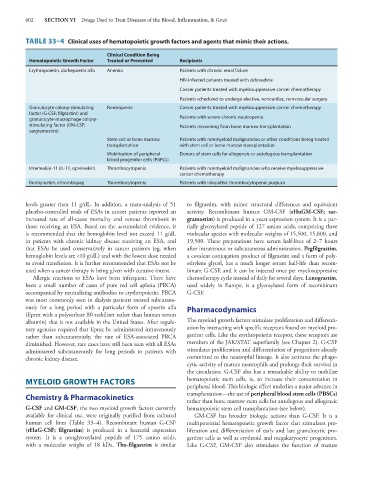Page 616 - Basic _ Clinical Pharmacology ( PDFDrive )
P. 616
602 SECTION VI Drugs Used to Treat Diseases of the Blood, Inflammation, & Gout
TABLE 33–4 Clinical uses of hematopoietic growth factors and agents that mimic their actions.
Clinical Condition Being
Hematopoietic Growth Factor Treated or Prevented Recipients
Erythropoietin, darbepoetin alfa Anemia Patients with chronic renal failure
HIV-infected patients treated with zidovudine
Cancer patients treated with myelosuppressive cancer chemotherapy
Patients scheduled to undergo elective, noncardiac, nonvascular surgery
Granulocyte colony-stimulating Neutropenia Cancer patients treated with myelosuppressive cancer chemotherapy
factor (G-CSF; filgrastim) and
granulocyte-macrophage colony- Patients with severe chronic neutropenia
stimulating factor (GM-CSF; Patients recovering from bone marrow transplantation
sargramostim)
Stem cell or bone marrow Patients with nonmyeloid malignancies or other conditions being treated
transplantation with stem cell or bone marrow transplantation
Mobilization of peripheral Donors of stem cells for allogeneic or autologous transplantation
blood progenitor cells (PBPCs)
Interleukin-11 (IL-11, oprelvekin) Thrombocytopenia Patients with nonmyeloid malignancies who receive myelosuppressive
cancer chemotherapy
Romiplostim, eltrombopag Thrombocytopenia Patients with idiopathic thrombocytopenic purpura
levels greater than 11 g/dL. In addition, a meta-analysis of 51 to filgrastim, with minor structural differences and equivalent
placebo-controlled trials of ESAs in cancer patients reported an activity. Recombinant human GM-CSF (rHuGM-CSF; sar-
increased rate of all-cause mortality and venous thrombosis in gramostim) is produced in a yeast expression system. It is a par-
those receiving an ESA. Based on the accumulated evidence, it tially glycosylated peptide of 127 amino acids, comprising three
is recommended that the hemoglobin level not exceed 11 g/dL molecular species with molecular weights of 15,500, 15,800, and
in patients with chronic kidney disease receiving an ESA, and 19,500. These preparations have serum half-lives of 2–7 hours
that ESAs be used conservatively in cancer patients (eg, when after intravenous or subcutaneous administration. Pegfilgrastim,
hemoglobin levels are <10 g/dL) and with the lowest dose needed a covalent conjugation product of filgrastim and a form of poly-
to avoid transfusion. It is further recommended that ESAs not be ethylene glycol, has a much longer serum half-life than recom-
used when a cancer therapy is being given with curative intent. binant G-CSF, and it can be injected once per myelosuppressive
Allergic reactions to ESAs have been infrequent. There have chemotherapy cycle instead of daily for several days. Lenograstim,
been a small number of cases of pure red cell aplasia (PRCA) used widely in Europe, is a glycosylated form of recombinant
accompanied by neutralizing antibodies to erythropoietin. PRCA G-CSF.
was most commonly seen in dialysis patients treated subcutane-
ously for a long period with a particular form of epoetin alfa Pharmacodynamics
(Eprex with a polysorbate 80 stabilizer rather than human serum
albumin) that is not available in the United States. After regula- The myeloid growth factors stimulate proliferation and differenti-
tory agencies required that Eprex be administered intravenously ation by interacting with specific receptors found on myeloid pro-
rather than subcutaneously, the rate of ESA-associated PRCA genitor cells. Like the erythropoietin receptor, these receptors are
diminished. However, rare cases have still been seen with all ESAs members of the JAK/STAT superfamily (see Chapter 2). G-CSF
administered subcutaneously for long periods to patients with stimulates proliferation and differentiation of progenitors already
chronic kidney disease. committed to the neutrophil lineage. It also activates the phago-
cytic activity of mature neutrophils and prolongs their survival in
the circulation. G-CSF also has a remarkable ability to mobilize
MYELOID GROWTH FACTORS hematopoietic stem cells, ie, to increase their concentration in
peripheral blood. This biologic effect underlies a major advance in
Chemistry & Pharmacokinetics transplantation—the use of peripheral blood stem cells (PBSCs)
rather than bone marrow stem cells for autologous and allogeneic
G-CSF and GM-CSF, the two myeloid growth factors currently hematopoietic stem cell transplantation (see below).
available for clinical use, were originally purified from cultured GM-CSF has broader biologic actions than G-CSF. It is a
human cell lines (Table 33–4). Recombinant human G-CSF multipotential hematopoietic growth factor that stimulates pro-
(rHuG-CSF; filgrastim) is produced in a bacterial expression liferation and differentiation of early and late granulocytic pro-
system. It is a nonglycosylated peptide of 175 amino acids, genitor cells as well as erythroid and megakaryocyte progenitors.
with a molecular weight of 18 kDa. Tbo-filgastrim is similar Like G-CSF, GM-CSF also stimulates the function of mature

